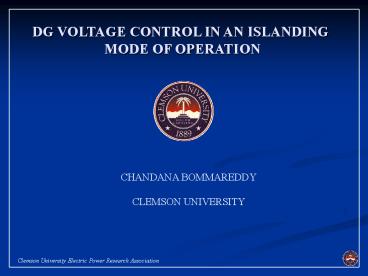Clemson University Electric Power Research Association - PowerPoint PPT Presentation
1 / 16
Title:
Clemson University Electric Power Research Association
Description:
Clemson University Electric ... -connected and stand-alone modes of operation Simulation of an IEEE bus feeder using PSCAD Simulation of synchronous generator ... – PowerPoint PPT presentation
Number of Views:188
Avg rating:3.0/5.0
Title: Clemson University Electric Power Research Association
1
DG VOLTAGE CONTROL IN AN ISLANDING MODE OF
OPERATION
CHANDANA BOMMAREDDY CLEMSON UNIVERSITY
Clemson University Electric Power Research
Association
2
Presentation Outline
- Purpose of the presentation
- Distributed Generation and the increasing
interest in distributed resources - Grid-connected and stand-alone modes of operation
- Simulation of an IEEE bus feeder using PSCAD
- Simulation of synchronous generator using PSCAD
- Simulation of induction generator using PSCAD
- To study their impact on the voltage in both the
modes and compare the results - Conclusion and future work
Clemson University Electric Power Research
Association
3
Purpose of the Presentation
- Operation of distributed generation systems (DGS)
in a standalone AC power supply - Voltage fluctuations due to many reasons
- Distribution networks and voltage stability
- Control voltage and frequency to the improvement
of the power quality
Clemson University Electric Power Research
Association
4
Distributed Generation
- Why is Distributed Generation so popular ?
- Speed mobility
- Higher efficiencies than centralized generation
- Reliability of power
- Flexibility choice to consumers
- Reduction of transmission and distribution costs
- Suited for small-scale generation in the
commercial and industrial sectors
Clemson University Electric Power Research
Association
5
Distributed Generation Technologies
- Considering only the electrical characteristics
there are three different DG types - Synchronous generator
- Asynchronous generator
- Photo Voltaic
- Other
Clemson University Electric Power Research
Association
6
Different modes of operation
GRID
DG
4.16 / 0.48 kV
LOAD
4.16 kV
480V, 1.5 MW
- Grid-connected mode
The utility is used as reference for voltage and
frequency. DG is assumed to be disconnected from
the grid in this mode of operation.
- Grid and DG connected mode
DG is assumed to be connected and operating in
parallel with the grid in this mode of operation.
- Stand-alone mode
The DG is disconnected from the grid and is its
in maximum mode of operation
Clemson University Electric Power Research
Association
7
Modeling of power system components
- IEEE 13 Node Test Feeder
Clemson University Electric Power Research
Association
8
Simulation of synchronous generator
Clemson University Electric Power Research
Association
9
Simulation of induction generator
Clemson University Electric Power Research
Association
10
Results and Discussions
Grid-connected mode with and without capacitors
Clemson University Electric Power Research
Association
11
Synchronous Generator with and without capacitor
Grid and DG mode
Clemson University Electric Power Research
Association
12
Induction Generator with and without capacitor
Clemson University Electric Power Research
Association
13
Stand-alone mode
Synchronous Generator
Induction Generator
Clemson University Electric Power Research
Association
14
CONCLUSIONS
- The steady state models developed, simulate the
operation of synchronous generator and induction
generator in the stand-alone and grid-connected
modes. - Both the models were used to study the
comparison of voltage magnitudes in the two
different modes of operation of the DG. - Results show the voltage magnitudes dropped
significantly in the stand-alone mode. - Capacitors connected at selected buses improved
the voltage magnitudes by 3 - 6 which is a
considerable increase. - Original capacitors in the grid-connected mode
may not help the islanding mode of operation.
Clemson University Electric Power Research
Association
15
FUTURE WORK
- Develop the following control mechanisms to
control the voltage in the stand-alone mode of
operation at 60 Hz - Synchronous Condenser
- Static VAR Compensator
- Tap Changing Transformers
- Voltage Regulator
- Other
- Develop detailed models of some DG control
methods that are described in Part I to control
harmonics due - Non linear loads
- DG model
Clemson University Electric Power Research
Association
16
- QUESTIONS ?
- THANK YOU
Clemson University Electric Power Research
Association































